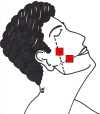Is post-operative antibiotic therapy justified for surgical removal of mandibular third molar? A comparative study
- PMID: 24822012
- PMCID: PMC4016398
- DOI: 10.1007/s12663-013-0495-6
Is post-operative antibiotic therapy justified for surgical removal of mandibular third molar? A comparative study
Abstract
Surgical removal of impacted mandibular third molar (SRIMTM) is the most common procedure performed in oral and maxillofacial surgery. In the literature, many complications associated with lower third molar removal are described such as pain, swelling, trismus, infection, inflammation, and nerve damage. Antibiotics are routinely used either pre-operatively or post-operatively to reduce the chances of surgical site infection (SSI). However routine use of antibiotics for SRIMTM is still controversial. For antibiotics to be effective in reducing post-operative infective complications, the time of administration is very important. Adequate serum concentration of antibiotic must be achieved prior to the procedure. In a developing country like India, antibiotics are routinely prescribed post-operatively. The current study is designed to evaluate the efficacy of post-operative prophylactic antibiotic in SRIMTM.
Keywords: Impacted mandibular third molar; Post-operative prophylactic antibiotic; Surgical site infection.
Figures


Similar articles
-
Role of Prophylactic Dose of Oral Amoxicillin Trihydrate in Prevention of Bacteremia Post Surgical Removal of Impacted Mandibular Third Molar: A Clinical Study.Indian J Otolaryngol Head Neck Surg. 2023 Dec;75(4):2907-2912. doi: 10.1007/s12070-023-03883-2. Epub 2023 May 25. Indian J Otolaryngol Head Neck Surg. 2023. PMID: 37974866 Free PMC article.
-
Efficacy of single dose azithromycin as prophylactic antibiotic in surgical removal of mandibular third molars: a clinical study.J Maxillofac Oral Surg. 2013 Dec;12(4):382-6. doi: 10.1007/s12663-012-0464-5. Epub 2013 Jan 11. J Maxillofac Oral Surg. 2013. PMID: 24431875 Free PMC article.
-
Comparative Evaluation of Immediate Post-Operative Sequelae after Surgical Removal of Impacted Mandibular Third Molar with or without Tube Drain - Split-Mouth Study.J Clin Diagn Res. 2016 Dec;10(12):ZC46-ZC49. doi: 10.7860/JCDR/2016/20951.9054. Epub 2016 Dec 1. J Clin Diagn Res. 2016. PMID: 28209003 Free PMC article.
-
Do antibiotics reduce the frequency of surgical site infections after impacted mandibular third molar surgery?Oral Maxillofac Surg Clin North Am. 2011 Nov;23(4):541-6, vi. doi: 10.1016/j.coms.2011.07.007. Oral Maxillofac Surg Clin North Am. 2011. PMID: 21982606 Review.
-
Prophylactic removal of impacted mandibular third molars: a systematic review and economic evaluation.Health Technol Assess. 2020 Jun;24(30):1-116. doi: 10.3310/hta24300. Health Technol Assess. 2020. PMID: 32589125 Free PMC article.
Cited by
-
Role of Prophylactic Dose of Oral Amoxicillin Trihydrate in Prevention of Bacteremia Post Surgical Removal of Impacted Mandibular Third Molar: A Clinical Study.Indian J Otolaryngol Head Neck Surg. 2023 Dec;75(4):2907-2912. doi: 10.1007/s12070-023-03883-2. Epub 2023 May 25. Indian J Otolaryngol Head Neck Surg. 2023. PMID: 37974866 Free PMC article.
-
Comparative efficacy of pre-operative and post-operative administration of amoxicillin in third molar extraction surgery - A systematic review and meta-analysis.Natl J Maxillofac Surg. 2024 Jan-Apr;15(1):29-35. doi: 10.4103/njms.njms_163_22. Epub 2024 Mar 19. Natl J Maxillofac Surg. 2024. PMID: 38690250 Free PMC article. Review.
-
Infection, Alveolar Osteitis, and Adverse Effects Using Metronidazole in Healthy Patients Undergoing Third Molar Surgery: A Meta-analysis.J Maxillofac Oral Surg. 2018 Jun;17(2):142-149. doi: 10.1007/s12663-017-1031-x. Epub 2017 Jul 1. J Maxillofac Oral Surg. 2018. PMID: 29618877 Free PMC article. Review.
References
-
- Peterson LJ, Booth DF. Efficacy of antibiotic prophylaxis in intraoral orthognathic surgery. J Oral Surg. 1976;34:1088. - PubMed
-
- Paterson JA, Cardo VA, Stratigos GT. An examination of antibiotic prophylaxis in oral and maxillofacial surgery. J Oral Surg. 1970;28:753. - PubMed
-
- Alanis A, Weinstein AJ. Adverse reactions associated with the use of oral penicillins and cephalosporins. Med Clin North Am. 1983;67:113. - PubMed
-
- Saglam AA. Effects of tube drain with primary closure technique on postoperative trismus and swelling after removal of fully impacted mandibular third molars. Quintessence Int. 2003;34:143–147. - PubMed
LinkOut - more resources
Full Text Sources
Other Literature Sources
